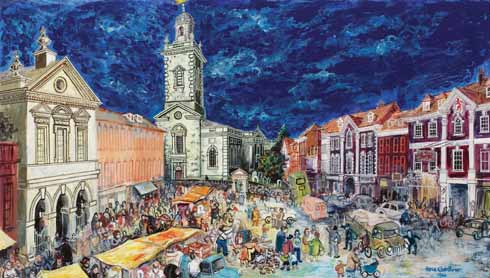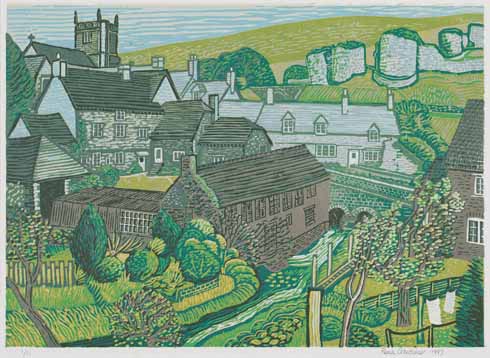Portrait of the artistof a portrait in Dorset
© the estate of Rena Gardiner, used courtesy of Little Toller Books
Published in December ’15

Mural of the old Bournemouth School for Girls, completed in 1961. It is 10ft x 30ft and can be found on the top landing at the top of the main staircase in the school’s current site. A firewall added later makes it impossible for a single photo to be taken of the mural. Oil on canvas panels
She was a one-woman publishing house, a self-contained artist, writer, researcher, designer, printer, bookbinder and distributor, running perhaps the definitive cottage industry from her thatched Tarrant Monkton home. She called it The Workshop Press and its imprint is to be found on the series of beautifully handcrafted guidebooks to historic sites and the natural landscape on which her public profile, such as it was, has largely rested since her passing in 1999.
Rena Gardiner came to Dorset in 1954, taking a cottage in Wareham and travelling to her day job teaching art at Bournemouth School for Girls on a Lambretta. By then she had already illustrated and printed one book and was a consummate printmaker, inspired by the lithograph makers such as John Piper and Eric Ravilious that flourished between the wars. Setting up a makeshift workshop and studio in her garage she continued to make prints and before long was producing her first books, soon outgrowing her garage and precipitating her move to Tarrant Monkton in 1965.
With more space in which to work if not live, within five years she had given up teaching and was focussing all her efforts on The Workshop Press producing books for clients including the National Trust. She shied away from publicity, although articles about her work did appear from time to time, had little interest in critical acclaim and not much more in financial dividends. She wanted the guidebooks to do well, they paid the bills, but the work was its own reward.
‘Each book would have taken her about two years to complete from start to finish,’ explains Julian Francis, co-author with Martin Andrews of Rena Gardiner: Artist and Printmaker (Little Toller Books). ‘She loved doing the research and wrote the text herself, as well as the drawings, the printing, collating all the paper, which was a huge undertaking, and then printing the books by hand. She would sometimes call on a few friends to help, but she was doing print runs of 10,000 to 15,000 for some of them, it was physically very demanding.’
Those guidebooks, there are about 40 in all, have been collected by enthusiasts such as Julian for many years, but since the publication of the book – already into its second print – things have started to change. Rena Gardiner’s work rarely comes up at public auction so a sale this summer in Crewkerne attracted a great deal of attention.
A copy of her 1960 book, Portrait of Dorset, of which fewer than 40 copies were printed before the plates were destroyed was estimated at £150-£250 but sold for £3100 and three other Dorset books made £500. The hammer came down on a near complete set of her printed works at £1150 and a group of 11 litho prints was sold at £2500.
The market for Rena Gardiner’s other art has, until very recently, been even more select, but the same sale saw a bound volume of drawings and watercolours from a European holiday entitled We Went To Wien (and wished we hadn’t) Summer 1962, achieve £1360; another illustrated notebook Ricordo di Roma (and other places) from 1961 saw bidding peak at £1650; while Souvenir of Holland, a portfolio of watercolours from a 1960 holiday made £2750.

The cover of Portrait of Dorset (1960), only thirty numbered copies and a few additional specimen copies were produced
All of which goes to show, if only by attaching prices to it, just how much her highly individual work is now being appreciated by those in the know, thanks in no small part to the success of the book.
‘We did the book to raise Rena’s artistic profile in the hope she might gain the recognition she appeared to have little interest in during her lifetime,’ says Julian. ‘Up until now the interest in her work has largely been a few nerdy collectors who happened upon it and fell in love with it, as I did when I first came to Dorset in 1980. I’ve collected her books ever since, but where there used to be 30 or 40 books readily available online at any one time, today there are only nine. So I think the book and the publicity surrounding can take some responsibility for that and it’s no bad thing as it is bringing Rena Gardiner’s fantastic work to a wider audience.’
The books are undoubtedly the most accessible point of entry into the world of Rena Gardiner, particularly her three foolscap Dorset volumes – The East Winterborne Valley (1968), The Isle of Purbeck (1969) and Tarrant to Blandford (1970) – but also her 1963 Corfe Castle guidebook and, when it can be found, Portrait of Dorset. In them Rena is unafraid to share her views, in both words and pictures. They are defiantly distinctive, utterly compelling and because the illustrations are from drawings made directly onto aluminium lithographic plates, no two copies of any title are the same.
However, perhaps her purest artistic expressions are to be found in the work she did entirely for her own reasons.
‘The books were her main source of income after she gave up teaching so to that extent they were a commercial operation – incredibly time consuming as it was, that was how she made her living. But she was a terrifically talented artist in several media and if anything the time the books took to produce probably prevented her from exploring her art in other ways.
‘Not only did she do some lovely oil paintings and watercolours, but pastels as well. There are some wonderful drawings she made in researching the books, particularly of the architecture, and the illustrated notebooks she made on holiday as well. Sometimes the images she painted were from the same drawings she’d previously made prints from so they’re not always entirely original and had she had more time maybe she would have taken a different approach.’
We’ll never know, but there are tantalising glimpses of Rena’s character throughout her work, such as in the enormous 10ft x 30ft mural made for Bournemouth School for Girls in 1960/61 to commemorate the original school buildings at the Lansdowne ahead of its move to a purpose-built campus close to Castle Lane. Lessons are captured in full swing, there’s an art class on the balcony, a school photograph being taken… and Rena includes herself astride her red scooter.
‘I love the little vignettes that she has included in
the BSG mural, they show a different side to her that’s also in the work she did for children’s books. I wanted this side to come out in our book so we’ve included a board game she designed for a leaflet and a puzzle inspired by Lindisfarne – there’s a more playful side of her on show, which is nice to see and I wish there was more of it. There’s also a wonderful drawing of the sculpture of Eve by Gislebertus that shows she was a very accomplished draughtsman as well.’

Rena fitting a lithographic printing plate onto the press at home in Tarrant Monkton. Photo by Martin Andrews in 1993, used courtesy of Little Toller Books
The solitary nature of much of Rena’s work suggests she was very comfortable in her own company and although she drew on trusted friends to help her complete her books she wasn’t one for parties or big social occasions. That said, in 1981, following the publication of a second book about St George’s Chapel at Windsor, she was invited by HM The Queen to attend the Garter Ceremony.
‘This required her to put on a dress and hat in which she felt most awkward; returning home she was relieved to don her normal practical attire of trousers and polo shirt,’ notes Julian in his text for the book.
‘I’ve not been told this but I suspect she didn’t suffer fools well,’ he says. ‘She was not naturally gregarious and did not participate in village life at Tarrant Monkton of drinks and dinner parties. She would though, if asked, gladly help out with cards to be sold for church funds, but generally she just got on with her work and saw the small circle of friends she knew from her days as a teacher.’
With the newly invigorated interest in Rena, an exhibition of her prints and other works is planned at Durlston Country Park in March and Julian’s co-author Martin Andrews, an avid and long-standing collector who spent a day with Rena at Tarrant Monkton in 1993, will be speaking about her work at Leigh village hall in November. It seems the new interest in the work of Rena Gardiner is growing all the time.
‘I rather suspect that we’ll see more Rena Gardiner work available for sale as people start to realise what they’ve got could have some value, at least in the relatively short term. After that I imagine it will continue as a collectors’ market, but since the book was published some more material has come out of the woodwork and we’ve been able to include images on the website that aren’t in
the book.’
The publication of Rena Gardiner: Artist and Printmaker, which includes an exhaustive list of her books, leaflets, cards and prints, has shone a light – albeit belatedly – on this most unsung of Dorset art figures and yet even now she remains something of an enigma. How pleasing. ◗
❱ www.renagardiner.co.uk
Rena Gardiner Exhibition
8-22 March, daily Fine Foundation Gallery, Durlston Country Park, Swanage, 01929 424443, www.durlston.co.uk
Martin Andrews will gave an illustrated talk on Rena Gardiner at Harman’s Cross Village Hall on Wednesday 1 June at 7.30. For more details see www.purbeckartweeks
Rena Gardiner: Artist and Printmaker by Julian Francis and Martin Andrews, published by Little Toller in association with The Dovecote Press, £25, available from bookshops or Little Toller, 01300 321536,
❱ www.littletoller.co.uk
Picture credits: © the estate of Rena Gardiner, used courtesy of Little Toller Books




